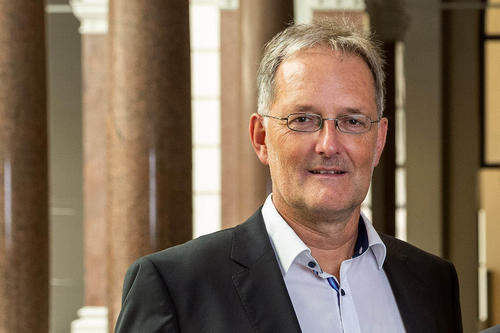“We can mathematize everything”
Christof Schütte, a professor of biocomputing at Freie Universität Berlin, discusses the role of biocomputing – in the pandemic and in wool sheep
Aug 05, 2021
Many processes can be simulated with the help of mathematics, for example, how wool sheep spread around the world.
Image Credit: pexels / Skitterphoto
Professor Schütte, do you have any early memories connected with your interest in mathematics?
My elementary school teacher told me that he did not need to teach me much more in math, so he let me play soccer on the playground while the others were inside doing math. He taught me at an early age that you can have a good life if you can do math. (He laughs.)
But math was not your first choice at university.
That’s right. First I earned a degree in physics and computer science with a minor in math. I wanted to do my doctorate in physics with a doctoral scholarship in New York. But then Peter Deuflhard, an eminent mathematician, invited me to Berlin to attend a meeting for scholarship holders of the Studienstiftung des Deutschen Volkes (German Academic Scholarship Foundation). He made me an offer that I could not refuse, namely an offer to do independently guided research without project constraints.
Do you think society as a whole underestimates the benefits of mathematics?
No, I notice a great deal of interest in math everywhere, including at the political level, but it is often the discipline behind the scenes and gets little attention. Mathematics provides insights, but we are not the first on television to explain how the pandemic is spreading. Virologists could not investigate nearly so much without the math in the background.
How do you collaborate with other disciplines?
We need a common language and the right contexts. In mathematics, for example, we created models for the spread of Roman culture in North Africa. Based on ancient studies and geology, we simulated how wool sheep spread around the world following a mutation in Asia Minor in the 6th millennium BCE. With large-scale dynamics and the modulation of all households in Germany, we could also simulate and help predict which incentive systems are suitable, for example, to help electric transportation achieve a breakthrough in this country. Everything that other sciences can describe, we can mathematize in cooperation with these subjects.
You head the Biocomputing Group at Freie Universität. Could you briefly explain what the work entails?
We combine scientific computing with computer reinforcement and efficient algorithms to solve life science problems, for example, to develop pain relievers.
Sticking with this example: Your group succeeded in translating an individually felt pain into a formula or a function that you then worked with mathematically to gain results useful in medicine. How did you do this?
Painkillers are small molecules that attach to molecules of the cellular structure. How they do it, how quickly they get there, how tightly they are bound there, and how long it takes to loosen them – all of these factors are crucial for the cellular effect that ultimately leads to pain relief.
After much back and forth, we came up with the idea that inflamed tissue, i.e., the place where the pain reliever should work, has a different pH value than healthy tissue. So we asked ourselves the question: Can a molecule be constructed in such a way that it only adheres to the cell surface when the tissue is inflamed, i.e., has a relatively low pH value, and does not bind when it is not inflamed? That actually worked out in the end.
Does that produce large amounts of data?
In drug development, the amounts of data are often not huge at first. We only generate these during simulations on mainframes. When analyzing data in medicine, which we are increasingly involved in, it is about terabytes or petabytes. Coping with these quantities is a challenge.
Christof Schütte is a professor of biocomputing and the spokesperson for MATH+, the Berlin Mathematics Research Center, which is a cross-institutional and interdisciplinary Cluster of Excellence.
Image Credit: Felix Noack
You were a board member of the DFG Research Center MATHEON, which was founded in 2002, and you have held various functions since then. What would you say was decisive for the success of the three major Berlin universities in the German Excellence competition?
In the first round in the Excellence Initiative in 2006/2007, we were able to look back on four successful years of MATHEON. The most important lesson from this time was how important trust is across the institutions. It turned out that we were able to benefit from this in the cross-university proposals in all the rounds of the Excellence competition.
We noticed that we could work together without killing each other (he laughs). The MATHEON budget was already at 6.5 million euros per year. Working together at MATHEON, we learned how to weave interests, even if they are very different, into compromises, and we learned how to inspire cooperation. This paved the way for the Berlin Mathematical School in 2006 and the MATH+ Cluster of Excellence in 2018.
How do you work together across the institutions now within the Berlin University Alliance?
Actually, we work according to the successful MATHEON model. All of the institutions are represented on the MATH+ Executive Board, where we make the most important decisions once a month. Through the board members, many people are involved in the decision-making processes. It is important that the Cluster of Excellence did not distribute all of its money at the beginning of the funding phase and that it has a very well-functioning fine-tuning system.
We hold a new project competition almost every year, so that new people from outside keep joining us. To be approved for funding, the projects must include at least two people from two institutions. That connects.
Berlin has an enormous density in mathematics, among other things through MATH+ and the Zuse Institute Berlin as well as the universities. Are there comparable regions elsewhere?
There are regions with the same research intensity in mathematics in London and New York, for example. Berlin, however, has one of the most pronounced application-oriented focuses in the world. That was an important factor in the German Excellence competitions.
What would you like to achieve in the two years of your tenure?
We started as a research cluster with the aim of changing something in the real world. That is what I stand for, it is what my colleagues who held the position before me stood for, and it is what those who take on this role in the future will stand for. Every new call issued by MATH+ focuses on this goal.
How can mathematics help combat the coronavirus pandemic?
We provide support by simulating the course of the pandemic. From the very beginning, we have mainly been pursuing the question of which measure – compulsory masks, closing schools, etc. – actually has which effect. They all work at the same time. We try to use simulations to look at the effects of each measure in isolation.
Another question also concerns us: every containment measure generates costs, for example, in social and economic terms. How can the number of infections be reduced without the costs becoming too great? Here, too, mathematicians can provide facts. It is then up to politicians to assess the facts and decide what kind of balance they want to strike.
Has anything positive come out of the pandemic?
The pandemic has shown us that lectures can also be given online, more than in the past, and that in the future some business trips can be avoided by using video conferences more often.
However, a very important aspect at scientific conferences is the informal discussions outside the regular meetings, where people can talk about various difficulties, errors, and solutions – many things that one does not want to spread to a large audience. Virtual meetings cannot really offer that, which is a detriment for us all. Like society as a whole, science must return to real encounters with people.
Carsten Wette conducted the interview.
This text originally appeared in German on July 3, 2021, in the Tagesspiegel newspaper supplement published by Freie Universität Berlin.
Further Information
- Professor Christof Schütte, Freie Universität Berlin, Department of Mathematics and Computer Science, Biocomputing Group, Email: schuette[at]mi.fu-berlin.de
- Biocomputing Group
- MATH+, the Berlin Mathematics Research Center


